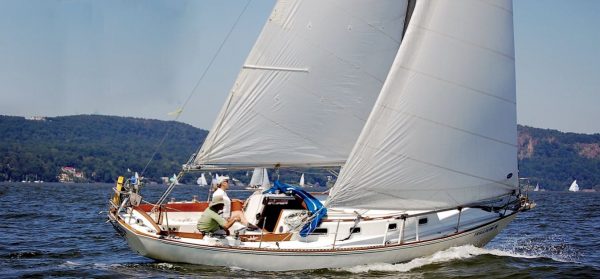This is an article from “Good Old Boat” (a magazine we like a lot), written by Rob Mazza. Good Old Boat and Rob have graciously allowed us to republish it for OCH members.

An exclusively North American phenomenon, the keel/centerboarder traces its origin to 1885 and the Boston design office of Eward Burgess. At a time when the difference between the deep-draft, heavy-displacement, narrow-beam (“plank on edge”) British cutters, and the beamy, shoal-draft, light-displacement American centerboarder was at its greatest, the British mounted back-to-back challenges for the America’s Cup with the Beavor-Webb-designed GENESTA and GALATEA, typical products of the British Tonnage Rules. The New York Yacht Club (NYYC), feeling the need to defend the “American Type,” responded with defenders in that traditional American style, causing A. Cary Smith to lament, “They’re forcing me to design a damned scow!” However, Burgess and the Boston syndicate headed by Paine, less restricted by the need to uphold American yachting “tradition,” responded with what was to become known as the “compromise” cutter, PURITAN, followed by in 1886 by MAYFLOWER and in 1887 by VOLUNTEER of the same type. Note the obvious New England names, emphasizing their non-NYYC origins. These successful defenders had narrower beam, deeper draft, and greater displacement and ballast than the typical “American Type” of the time but still utilized a centerboard protruding down through a slot in the external ballast keel. The introduction of the Burgess compromise marked the end of the extremes in yachts on opposite sides of the Atlantic, and the Mercer 44 and its contemporaries can certainly stretch their ancestry back to these “compromise” cutters of the 1880s.
. . . sign up to the right to get immediate access to this full post,
plus you'll get 10 of our best videos for free.
Get Free Videos& Learn More Join Now!!for Full Access Members Sign In


jan labij says:
Yeah, I grew up on centerboarders, and am looking for another one. At the same time, I’ve joined the “smaller is better” school of construction.
Gary S Uhring says:
Ted Hood sailed Robin in the seven race 1973 SORC finishing third overall in a +150 boat fleet. The 36ft Robin was a centerboard boat with no keel internal ballast. The 25 boat One Ton class all rated the same IOR Rule 27. Olympian John Dane was first overall, second overall Ted Turner, we were forth overall, a centerboard vs. keel boats. Match racing with 36ft offshore boats.
Robert Williams says:
A great collaboration, look forward to more.
DICK ELKINTON says:
Enjoyable article. As a boy my family had an old Chesapeake schooner w/cb, grandfather had two Hinckleys, wood & fiberglass, with cbs, and I have owned a variety of boats all w/fin keels. After a 20 year layoff and at the age of 65 I have purchased a very different centerboarder! It is a J95 that draws 3′ w/board up and 5.5′ down. It is a wonderful sailing boat w/or w/o the board down. I sail on Lake Winnipesaukee now, and I can actually get into docks, even this year with the lake down 1.5′ plus.
James Reinhard says:
Owned a Tartan 27 keel centerboard sloop. Deceptively fast, weatherly, carried her way through the Lake Erie chop, sailed herself like she was on rails. Would be nice to have a few production boats like her today.
Paul Osborne says:
Newer boats that have used this design with success, Ericson 25cb. In small craft it seems to be a compromise. Keel with out the draft when you do not need it.
Peter MacLearn says:
I believe that Ted Hood had some successful outcomes with his centerboard- keel boats, aka Robin.
Christopher Chadbourne says:
I’m reminded of a book in my library authored by Maurice Griffiths. “Little Ships and Shoal Waters” is his epistle to his narrow-deep countrymen about the joys of shoal water sailing and the challenges of designing centreplate sailboats. The entire second half of the book is devoted to drawings and descriptions of shoal draft cruisers, with plenty of centerboarders by designers on both sides of the Atlantic.
John Wujack says:
I greatly look forward to OCH’s collaboration with GOB. For me, it’s a match made in heaven.
David Hagler says:
(I know this is an old post, but I agree!) I would pay a little more of a premium to get digital copies of GOB as part of my OCH membership.
Tim Roberts says:
Could someone provide a list of production k/CB designs. Our Cape Dory seems to find the ever shifting sandbars on the Mississippi all to regularly. A CB would sure help around here.
Kent Lewis says:
What size Cape Dory? The Drascombe Lugger is a fun 18′ 9″ centerboard yawl, still being built in the UK and often seen on craigslist. Our Lugger is named “Onkahye” (Seminole Indian word for “Dancing Feather”) after an 1839 Robert Stevens keel/centerboard schooner that saw service in the US Navy. http://slaveshiptrouvadore.org/antipiracy-antislavery-patrols/us-schooner-onkahye/
Rick Kennedy says:
The Yankee Dolphin 24 is a wonderful drop-centerboard sloop. Check out their website.
steve congdon says:
Great. I knew I loved my k/CB Rhodes for more reasons..20 inch draft. And upwind ability
john purdom says:
An interesting article- filling in some gaps of my knowledge of a the origins of a boat I worked on in the 70’s, a gaff rigged schooner, John Alden designed, called Puritan. She was built by the Electric Boat Company of Groton Connecticut in 1931.She had a centreboard, and a riveted steel hull, a consequence of the Electric boat Company’s expertise in Submarine pressure hulls.Still extant, in good shape, now in the Mediterranean.
David Tew says:
An article on the fore and aft ‘trimming’ centerboards of J Class yachts of the1930s would be interesting, too.